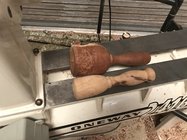A friend of a friend saw my work and has been looking for a new hobby. I have been turning for 5 years both facework and cetnerwork, and want to help him start the right way. Plenty of tools, enough experience and 3 different size lathes, so I am ready top help and teach.... but I want a syllabus. Does anyone have like a power point or work document the guides a teacher through the right steps of the process. Otherwise, i am pretty sure, i might be kinda scattered. Looking for a doc that someone has already created which could help keep me on track. I can make one myself, of course...but I figured I would reach out here cuase someone has to have made something similar in the past.
Thanks!!
Nick
BTW - if this is the incorrect forum, please let me know so I can post it in the correct forum. Thanks again!
Thanks!!
Nick
BTW - if this is the incorrect forum, please let me know so I can post it in the correct forum. Thanks again!

